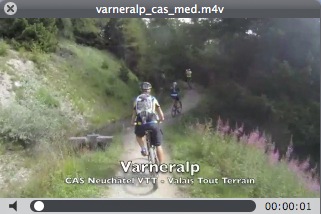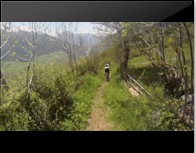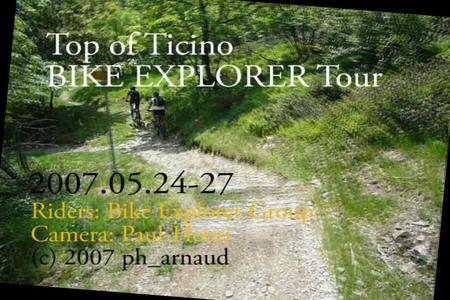Traditional mountain bike videos use either an entire video camcorder attached to the helmet, or use an external video lens fed to a camcorder in the backpack.
This is too cumbersome for me, although it gives good quality.
I currently use a GoPro HD, mainly because it is less fragile than my previous system, and keeps my camera free for pictures.
My previous system was to put an entire digital camera (with decent video mode) to the helmet. This is better than the GoPro because my digital cameras included stabilization, which the GoPro doesn’t have.
Ingredients:
1 good fitting helmet (helpful to experiment before if tripod will fit well as well on helmet)
1 (or 2) mini tripods (Ultrapods) – with 2 you can have one setup for forward looking videos and the other setup for rear looking videos
1 Niterider helmet mount (optional depending on your helmet, I have this on anyways, and it helps hold the tripod from slipping forward, and properly orienting the rear video tripod)
1 digital camera (light as possible, wide angled (28mm) as possible, good image stabilization built in, decent video mode, 1 or more Gb video card)
It is funny looking, but it is quick to setup when you keep your tripods dedicated for this purpose. As well it is very light and you really almost don’t feel any weight at all.
Here’s a quick comparison:
Entire video camcorder on helmet:
(see http://www.petefagerlin.com/ or http://www.utahmountainbiking.com/goodies/mini-dv.htm for examples/details)
Positive:
+ best quality video (best colors/contrast, fastest adjustment to brightness change, etc.)
+ good optical or electronic image stabilization
+ standard video format for easy editing, lots of recording time on cassettes
Negative:
– heavy overall system weight (usually camcorder weight x 2 with counterweight system)
– heavy weight on head
– effort to mount camcorder to helmet
Remote external video lens (bullet or lipstick camera):
Positive:
+ low helmet weight
Negative:
– poor picture quality
– no image stabilization
– heavy overall weight (still have camcorder in backpack)
– complexity, lots of extra batteries to keep charged, cables, etc.
Digital camera on helmet:
Positive:
+ better image quality than external video lens system (image stabilization included in many digital cameras)
+ low overall weight and low weight on helmet
+ mounts with easy to find pieces
Negative:
– video quality issues still (many cameras give purple lines with sun, bright lights or reflections of sun)
– sometimes video format issues depending on camera and editing software
– more limited video recording time (I get 20min on a 2 Gb card), but this is also a good thing, it limits the video footage you have, and once you start working on video editing you’ll appreciate spending 2 hours editing, instead of half a day.
GoPro HD
Positive:
+ Sturdier and smaller than digital camera
+ Comes with waterproof case (but sometimes fogging issue, and microphone doesn’t work so well
+ Comes with non-waterproof case, no fogging, microphone works better
+ Ok to good video quality, I don’t seem to get same saturated colors as on GoPro website examples, need to find out why
+ Wide angle
+ Among the low weight options
Negative:
– No video stabilization, currently treat with iMovie on Mac that helps sometimes
– Almost too wide angle for a number of situations
– Fogging issue with waterproof case, however will try the anti-fog strips that GoPro sells
– No preview/display, takes trial and error to find good angle, and then you need to mark this with pen yourself, mounting system for helmet should have degree markings.
Before I had a digital camera with image stabilization, I post-processed videos with SteadyHand software. This could help stabilize pre-stabilized videos even more, but just takes a lot of time and disk space, and slightly reduces how wide angle the image is, and can lead to a slight color loss or picture quality, so I skip this now that I have a little bit stabilized video coming directly from the camera.
Now that I have a Mac, I use iMovie built-in stabilization support. Still somewhat time-consuming but less of a hassle than a 3rd party software.
I often do multi-day rides with no vehicle support, so it isn’t an option to lug around another kilo or so of camcorder, or second helmet. I usually do have a digital camera with me, so the only extra weight is a mini tripod. But hats off to those who produce excellent videos using the camcorder on a helmet technique! Also I do hope some day someone will offer the remote video lens of high quality and with built in image stabilization or the GoPro will offer built-in image stabilization.
Some videos posted to this blog using GoPro HD:
Video 15mb download:

Video (25MB download, .m4v (quicktime format)):

Some videos posted to this blog using digital camera technique:
Video:Right click here to download 3 minute, 30MB video (.WMV format):
Video: Right click here to download 4 minute, 31MB video (.WMV format):
Video: Right-click here to download a 7 minute, 28 MB video (.WMV format):
